IF you want to know some Nuclear - Interesting Facts
IF you want to know what Nuclear Energy is....... Nuclear energy is the energy stored in the nucleus of an atom. It can be used to produce electricity. But, before it can used, it must be released. The enormous energy that is stored in the bonds that hold atoms together can be released by two processes: nuclear fission or nuclear fusion. In nuclear fission, larger atoms are split to form smaller atoms, releasing energy whereas in nuclear fusion hydrogen atoms are combined or fused to form a larger atom. This is how the sun produces energy.
Nuclear fusion is the most efficient way to create power through nuclear processes. It involves putting two atoms together to make one. The technology has never been implemented on a broad scale, so almost all nuclear power plants use nuclear fission – which splits one atom into two.
IF you want to know where energy comes from.....
All energy comes from a nuclear energy origin:
- Solar and wind come from the interaction with energy from nuclear fusion in the Sun.
- Oil and coal come from solar chemical interactions that created oil and coal reserves from dead plants.
- Geothermal: Comes from the heat of the Earth’s interior caused by decay of radionuclides.
- Hydro: Comes from solar energy that evaporates water and moves it into rivers where its potential energy is converted to electricity.
- The largest nuclear reactor is actually the Sun. It uses nuclear fusion reactions, a natural process, to convert hydrogen to helium.
IF you want to know what other useful applications for Nuclear Energy.....
- Nuclear medicine is used to diagnose and treat many different diseases. It uses isotopes to explore the body. Another version of it is radiotherapy, which is used to treat certain cancers by using radiation to target and destroy cancer cells.
- Project Prometheus is the NASA initiative to use nuclear power for long distance space exploration. The use of nuclear power as a primary fuel source could increase speeds and cut costs of missions.
- Uranium isn’t new. While using it as a source of power is new, during the middle ages it was used to transform the color of glass.
- Nuclear batteries, driven by the decay of a radioisotope called Pu-238, supplies energy for all space missions to the outer planets.
- Nuclear sources are routinely used by geologists to measure water content in rock.
- High radiation sources are used to sterilize medical instruments
- High radiation sources are used to sterilize food (but not in America) efficiently. That is why you can buy milk that is perfectly good for you off the non-refrigerated shelf in Germany.
IF you want to know some Nuclear firsts....
- During the Manhattan Project, a research team based in Chicago in 1942 headed by Enrico Fermi, produced the first functioning nuclear reactor design.
- The former Soviet Union was the first world power to use nuclear energy to produce electrical power. The Obninsk Power Plant came online in 1954.
- The US was the second global power to allow for commercial reactors to produce electricity. The Shippingport Power Plant came online in 1957.
- The US was the first global power to use a nuclear powered submarine. The USS Nautilus was launched in 1954. It was the first submerged vessel to travel under the North Pole and remained in service until 1980.
- The largest surface nuclear powered ship is not only over 50 years old, it’s still in service. The USS Enterprise was put into service in 1960 and is 1,122 feet long.
IF you want to know what is the largest producer of carbon-free electricity in the World........ The United States is the world’s largest producer of nuclear power. It generated 807.1 billion kilowatt hours of electricity in 2018—the highest total ever.1
- Commercial nuclear power plants have supplied around 20% of the nation’s electricity each year since 1990.
- Nuclear energy provided 55% of America’s carbon-free electricity in 2018, making it by far the largest domestic source of clean energy.
- 98 commercial nuclear reactors in the US are neighbors to over 3 million people, all who live within 10 miles of them.
- While the process of getting all of the materials to build a nuclear plant create as much environmental pollution as solar and wind production, the process of using nuclear energy, solar and wind have no significant environmental impact. Using fossil fuels contributes to pollution at every stage of production and use.
It can cost over 6 billion dollars to build one new 1 GW reactor in the United States. China routinely builds safe reactors for $2 billion each.
IF you want to know how many countries use Nuclear Energy..... Worldwide, there are over 430 commercial nuclear reactors producing energy for 31 countries.
- Italy phased out nuclear long ago and pays a huge premium to France to buy peak power from them.
- Germany closed their nuclear plants which caused prices of electricity to soar and pollution to increase.
- Sweden and Switzerland have shown no propensity to “phase out” nuclear energy.
IF you are concerned about how much Greenhouse gases a nuclear power plant produces...... Nuclear power plants do not emit greenhouse gases while generating electricity. They produce power by boiling water to create steam that spins a turbine. The water is heated by a process called fission, which makes heat by splitting apart uranium atoms inside a nuclear reactor core.
IF you want to know roughly how much land is needed for Nuclear Carbon Free Energy as compared to other Green energies..... As an example a currently planned 690 MW array of solar panels, to be built in the Valley of Fire area in Nevada, (which has been contested by environmental groups), takes up 7,100 acres. Next Generation Nuclear plants would be closer to 50 acres (possibly 1,000 acres for current generation reactors) with three times that capacity of the solar array, or roughly 21,000 solar panel filled acres (32.8 square miles) would equal the electrical output of one nuclear energy plant (under 1/8th of a square mile).
Renewables still need subsidies to be economically viable and they need back-up fossil fuel to smooth out times when they do not produce power. Next generation nuclear will cost around $3,000 per kW to install (when mass produced) which is about the cost of storage capacity for renewables. Some of the costs of renewables have not been included in the estimates (about a third the life of nuclear plants, battery backup less than a tenth of the life of nuclear plants 2, disposal costs of solar panels which will be expensive because of the toxins in them, and capacity factors about a third of nuclear and other base-load power sources).
While Wind is considered a green source of energy, then why do they require so much fossil fuel to back it up when the wind does not blow or to fuel aircraft to de-ice the turbine blades in the winter?
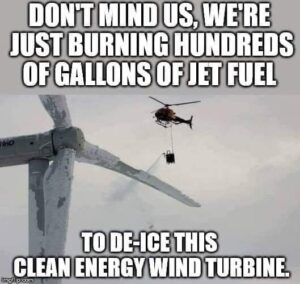 And as for Safety this is far from the first time workers (as in first picture below) have perished while maintaining and fixing these problem wind turbine plagued systems.
And as for Safety this is far from the first time workers (as in first picture below) have perished while maintaining and fixing these problem wind turbine plagued systems.
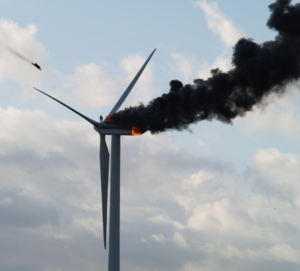
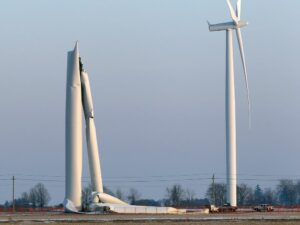
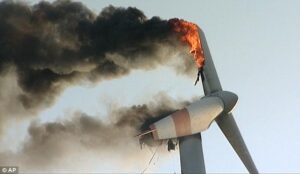
If you can “solve the climate issues” by only using renewable sources, why do renewable projects still need subsidies and why aren’t installations with subsidies not even keeping up with increases in the electricity demand in the US, let alone eliminating the need for fossil fuel plants?
IF you would like to know how reliable nuclear power plants are......... Nuclear Energy is the most reliable energy source in America. Nuclear power plants operated at full capacity more than 92% of the time in 2018—making it the most reliable energy source in America. That’s about 1.5 to 2 times more reliable as natural gas (58%) and coal (54%) plants, and roughly 2.5 to 3.5 times more reliable than wind (37%) and solar (26%) plants.
Nuclear power plants are designed to run 24 hours a day, 7 days a week because they require less maintenance and can operate for longer stretches before refueling (typically every 1.5 or 2 years).
Often, the only power sources running during a hurricane or typhoon are nuclear power plants.
IF you are curious of how much nuclear energy we already use.... Nuclear helps power 30 states. As of September 2018, 98 commercial reactors continue to help power homes and businesses in 30 U.S. states. Illinois has 11 reactors—the most of any state—and joins South Carolina and New Hampshire in receiving more than 50% of its power from nuclear. 1 in 5 households and business in the US are electrically powered by nuclear energy.
Nuclear fuel is extremely dense, because of this, the amount of used nuclear fuel is not as much as you think. The volume of fuel needed to supply the power used by one person in the United States for a lifetime is about the same as a 12-ounce soda pop can.
All of the used nuclear fuel produced by the U.S. nuclear energy industry over the last 60 years could fit on a football field at a depth of less than 10 yards.
IF you want to know what has happened to nuclear weapons that have been dismantled..... The United States Commercial Nuclear power plants have used at least 10% of Russia's destroyed nuclear weapon stockpiles in our plants as fuel.
The first developed country to follow through on the agreements to destroy nuclear weapon stockpiles and cease production of nuclear weapons was South Africa. A newcomer to nuclear warfare, they had only developed nuclear weapons in the late 1980's.
IF you want to know how much Spent Nuclear Fuel is actually created bey using Nuclear Energy to produce electricity...... Nuclear fuel is extremely dense, because of this, the amount of used nuclear fuel is not as big as you think. All of the used nuclear fuel produced by the U.S. nuclear energy industry over the last 60 years could fit on a football field at a depth of less than 10 yards.
Every year and a half to two years, every nuclear plant goes through a cleaning cycle that shuts down the plant to allow for the removal of Spent Nuclear Fuel.
IF you want to know why Spent Nuclear Fuel is not currently being recycled..... Recycling Spent Nuclear Fuel (SNF) is a relatively simple technological issue and the least complicated phase of the nuclear fuel cycle. In fact, the only reason we have a problem is that the US Government got involved. In fact, the only reason we have a problem is that the US Government got involved. Recycling SNF is far less costly (roughly $25 Billion in today's costs) than burying (over $200 Billion in 2008 costs) it and we can use it to make fuel for next generation reactors which can extract almost all of the energy in the nuclear fuel, instead of only 4-5% as we do today.
Even though France, Japan, Russia, and India recycle SNF, no evidence of any clandestine diversion of material has ever been found. North Korea started from scratch and created a bomb without using any SNF except what they produced on their own.
IF you would like to know how much of energy (electricity) is produced by carbon (dirty) fuel....... Today 96% of the energy we use globally is sourced from hydrocarbons (oil, natural gas and coal), and only 4% comes from renewables and nuclear.
Tens of thousands of Americans die every year from old-fashioned air pollution, generated by electric power plants that burn fossil fuels. Estimates vary, but between 7,500 and 52,000 people in the United States meet early deaths because of small particles resulting from power plant emissions. That’s huge. It is roughly comparable to the 40,000 people that died in car crashes in 2016.
IF you are concerned about the health effects from nuclear power plants, please consider those other forms such as coal that is still a large percentage of power producer..... In 2000, 2004 and again in 2010, the Clean Air Task Force (CATF) issued studies based on a methodology and a model created by Abt Associates, U.S EPA’s own health benefits consultant, based on peer-reviewed, published studies by the nation’s leading public health researchers, quantifying the deaths and other adverse health effects attributable to the fine particle air pollution resulting from coal-fired power plant emissions.
Since 2004, CATF has presented this data on the Toll from Coal website in the form of an interactive map that allows the user to click on individual power plants to learn the health impacts attributable to each. Using the most recent emissions data available (2016), in this 2018 study, CATF has updated our estimates. The “Toll from Coal” map above is available here.
This latest report finds that over 3,000 deaths each year are attributable to fine particle pollution from U.S. power plants. This represents a dramatic reduction in power plant health impacts from the previous studies. Our initial study in 2000 estimated the number of attributable deaths at 30,000 per year. In 2004, the number of attributable deaths in the 2010 study was 24,000. By 2010, the number was roughly 13,000 deaths per year. In 2014, that number had fallen to 7,500 deaths. 3
The economic value of health impacts from fossil fuel electricity, as reported by the U.S. Environmental Protection Agency in February 2013, in the United States is estimated to be $361.7 - $886.5 billion annually, representing 2.5-6.0% of the national GDP. 4
IF you want to know about some Fossil Fuel and Hydro Energy Disasters in history..... In the entire history of nuclear energy production, there have only been 3 major disasters – Three Mile Island, Fukushima, and Chernobyl. In the past 25 years, there have been over 10 major disasters with fossil fuel energy – the first largest of which was the Exxon Valdez, an oil tanker, on March 24,1989 and then the largest, the BP oil drilling rig - Deepwater Horizon oil spill on April 20, 2010.
- The Exxon Valdez oil spill was a man-made disaster that occurred when the Valdez oil tanker owned by the Exxon, spilled 11 million gallons of crude oil into Alaska’s Prince William Sound. The oil slick covered 1,300 miles of coastline and killed hundreds of thousands of seabirds, otters, seals and whales. At that time it was the worst oil spill in U.S. history, nearly 30 years later, pockets of crude oil still remain in some locations.
- The BP oil drilling rig Deepwater Horizon, operating in the Gulf of Mexico, exploded and sank resulting in the death of 11 workers on board and became the largest spill of oil in the history of marine oil drilling operations. 4 million barrels (more than 200 million gallons) of crude oil flowed into the Gulf of Mexico for a total of 87 days before it was finally capped on July 15, 2010, making it the biggest oil spill in U.S. history. 16,000 total miles of coastline have been affected, including the coasts of Texas, Louisiana, Mississippi, Alabama, and Florida.
- The Banqiao Reservoir Dam a dam to provide electrical power generation and also to control flooding and on the River Ru a tributary of the Hong River in Zhumadian City, Henan province, China. In 1975 during Typhoon Nina it failed catastrophically.
Its failure in 1975 caused as many as 230,000 deaths. The Hydrology Department of Henan Province reported that approximately 26,000 people died in the province from flooding and another 145,000 died during subsequent epidemics and famine. In addition, about 5,960,000 buildings collapsed, and 11 million residents were affected. Unofficial estimates of the number of people killed by the disaster have run as high as 230,000 people. - Over 1,750 Coal Miners have been killed in coal mine disasters, accidents in the United States. 5 Disasters listed below: (US Mine Disasters Fast Facts - CNN Library)
-
- December 6, 1907 - Worst coal mine disaster in US history: 362 miners are killed in an explosion at the Monongah Mines in West Virginia.
- November 13, 1909 - 259 miners are killed in a fire at the Cherry Mine in Cherry, Illinois.
- October 22, 1913 - An explosion kills 263 at the Stag Canon No. 2 Coal Mine in Dawson, New Mexico.
- June 8, 1917 - 163 miners are killed in a fire at the Granite Mountain Shaft Mine in Butte, Montana.
- January 10, 1940 - 91 miners are killed by an explosion at Pond Creek No. 1 in Bartley, West Virginia.
- March 16, 1940 - An explosion at the Willow Grove No. 10 mine in St. Clairsville, Ohio kills 72 miners.
- March 25, 1947 - 111 miners are killed in an explosion at the Centralia No. 5 mine in Centralia, Illinois.
- December 21, 1951 - An explosion at Orient No. 2 mine in West Frankfort, Illinois kills 119 miners.
- November 20, 1968 - 78 miners are killed by an explosion at Consol No. 9 miner in Farmington, West Virginia.
- December 30, 1970 - 38 miners are killed in an explosion at Nos. 15 and 16 Mines in Hyden, Kentucky.
- May 2, 1972 - 91 miners are killed in a fire at the Sunshine Mine in Kellogg, Idaho.
- April 15, 1981 - 15 miners are killed by an explosion at Dutch Creek No. 1, in Redstone, Colorado.
- December 19, 1984 - 27 miners are killed in a fire at the Wilberg Mine in Emery County, Utah.
- September 23, 2001 - 13 miners are killed by an explosion at the No. 5 Mine, n Brookwood, Alabama.
- July 24, 2002 - Nine coal miners in Somerset County, Pennsylvania, All survive and are rescued on July 28.
- January 2, 2006 - explosion at the Sago Mine in Tallmansville, WVa, 12 die - carbon monoxide, only one survived.
- May 20, 2006 - Five miners are killed in an explosion at the Darby Mine in Harlan, Kentucky, only one, survives.
- August 6, 2007 - Six miners trapped at the Crandall Canyon Mine in Huntington, Utah, when mine collapses.
- August 16, 2007 - Three rescue workers are killed and six are injured when a part of the mine collapses on them.
- August 31, 2007 - Search for 6 miners is called off and declared too dangerous for continued rescue efforts.
- April 5, 2010 - 29 miners are killed in an explosion at the Upper Big Branch mine in Naoma, West Virginia.
Three Tokyo Electric Power Company's (Tepco) employees at the Fukushima, Daiichi and Daini Nuclear Power plants reactors were killed directly due to the March 11, 2011 magnitude 9.0 earthquake and tsunami. The resulting tsunami caused a nuclear accident. However, were no casualties attributable to this nuclear accident.
1500 plus deaths were attributable to the mass evacuation and approximately 20,000 deaths were a direct result of the 9.0 magnitude earthquake and resulting tsunami.
If you want to know why Russia’s Chernobyl Power Plant history has seen one controversy after another...... Chernobyl and all similar plants were both constructed and operated in that country with ideology that did not emphasize the safety of a power plant, but rather with a massive design in mind, which had inherent design flaws that would never have been considered acceptable in western nuclear countries.
April 26, 1986, the Chernobyl nuclear power plant’s Unit 4 reactor melted down outside Pripyat, Ukraine. If the reactor was run within the proper operating parameters, backup systems would have kept them operating safely. These safety systems were purposely shut down during a Chernobyl experiment that led to its criticality and eventual mass heating of steam that blew the un-contained open Steel warehouse type building apart. There is speculation that even if pressure vessels would have been breached anyway, but the effect would have been much more localized. In short, the RBMK-1000 reactor type contained no pressure vessel protection.
Analysis of scientific results established after the accident demonstrates that shortcomings in the design, and freak infringements of safety regulations for the construction as well as inadequate documentation for reactor operation were the main reason of the Chernobyl accident.
The reactor was housed in an uncontained open Steel warehouse type building, a simple thing like including a containment structure (like all US Reactors have) around the inherently design flawed of the RBMK (abbreviation in Russian: a channel-туре reactor of a large power) could have greatly reduced if not kept all fallout from escaping from that accident.
A fifth and sixth reactor units under construction at that time and those projects were halted soon thereafter.
if you want to know what most of the world does not know is that Chernobyl still operated for years to come..... officials kept the Chernobyl Power Plant open and producing power in the three other operating reactors, Units 1, 2, and 3 in the wake of the aftermath for almost 14 years, sending workers to work daily despite of the set 19-mile exclusion zone. No non-nuclear replacement power plant could come close to generating the same amount of power, and building a new energy plant would take money and time that the struggling Russian nation did not have at that time.
In 1991 after being damaged by a fire, Unit 2 shut down. Unit 1 closed in 1996. The final unit, Unit 3, international negotiations finally shut it down in 2000, the plant was closed for good.
IF you would actually like to know how many people died as a result of the 1986 Chernobyl disaster.......... The April 26, 1986 Chernobyl, Soviet Union disaster, a result of a flawed reactor design and inadequately managed personnel led to an ill-advised backup generator experiment. This experiment led to a power surge which overheated the fuel rods of reactor no. 4 of the Chernobyl power plant, causing an explosion and meltdown, necessitating the evacuation of 300,000 people from the Chernobyl area. 100% of the volatile radioactive material from the reactor core was released into the atmosphere and spread across Europe. Two power plant workers died directly from the accident, 134 emergency workers sent to the site were later hospitalized with radiation sickness of those 28 later died.
The nuclear industry has a safer record than any other energy industry by orders of magnitude, even when Chernobyl (the only accident with any casualties - 28 directly as compiled by the World Health Organization) is considered. This includes the renewable energy business.
Next-generation reactors show promise to have an even better record of safety because they will fail by shutting down, not by going out of control, even without external safety backups.
IF you are curious about how much natural radiation you are exposed to in a year..... A chart of the public's exposure to ionizing radiation shows that people generally receive a total annual dose of about 620 millirem. Of this total, natural sources of radiation account for about 50 percent, while man-made sources account for the remaining 50 percent.
A person would receive a dose equivalent of 1 mrem from any one of the following activities:
- 3 days of living in Atlanta
- 2 days of living in Denver
- 1 year of watching television (on average)
- 1 year of wearing a watch with a luminous dial
- 1 coast-to-coast airline flight
- 1 year living next door to a normally operating nuclear power plant
Take your own Personal Annual Radiation Dose Calculator test.
IF you are worried about a terrorist flying an aircraft into a nuclear plant, then..... In 1988, the US government's Sandia National Laboratory took the initiative to examine the strength of reinforced concrete measuring 3.66 meters (12 feet) thick by launching a fully-loaded F-4 Phantom jet directly, traveling at 500 MPH to investigate the survivability of a nuclear power plant in the event of a terrorist attack. It was a slab of reinforced concrete the thickness of the walls of a nuclear plant. The jet dissolved upon impact, leaving the wall almost completely unscathed. (See complete Video)
The Nuclear Energy Institute released the results of an Electric Power Research Institute (EPRI) study that evaluated the impact of a Boeing 767 - the type of aircraft used in the September 11th terrorist attacks. Engineers were confident that nuclear power plant containment buildings can safely protect the reactor against most commercial aircraft (including Boeing 757's and 777's), assuming the most realistic scenario in the unlikely event that an airliner is hijacked and used to attack a nuclear power plant.
The nuclear industry is very confident that the containment building would safely protect the reactor in the unlikely possibility that a commercial airliner is used as a weapon against nuclear power plants. The Boeing 767 - aircraft would not likely penetrate the robust containment buildings where the reactor is located. Neither the mass of the aircraft nor the engines would likely penetrate the containment building.
The study also analyzed a Boeing 767 hitting a spent fuel vault, and although there may be significant damage to the 4 to 5-foot thick concrete vault walls it would absorb most of the energy from the aircraft, the stainless steel liner would remain intact with no penetration of the vault protecting the used reactor fuel.
IF you want to know the impact of the Fukushima on the future of nuclear power.....
The event at Fukushima in 2011 led to many countries stopping plans for increased nuclear power plants, while others are staying on track. It should be noted that growing countries, such as China and India, are still pursuing nuclear power. This also caused a downgrade and the predicted amount of energy that nuclear plants would provide to the global economy. This has led to concerns over what could be used to fill the gap in need by 2035.
If you consider all the people who are killed due to auto accidents each year........ Nearly 1.25 million people die in road crashes each year, on average 3,287 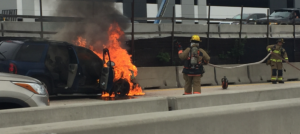
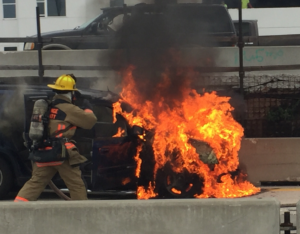 deaths a day. An additional 20-50 million are injured or disabled. Over 1,600 children under 15 years of age die each year, nearly 8,000 people are killed in crashes involving drivers ages 16-20, road crashes cost the U.S. $230.6 billion per year! 6 We do not protest where these vehicles are produced and ask our politicians to stop production of these killing machines! Yet the vast majority of Americans who do not understand this Carbon Free Nuclear form of energy production want these great form of mass produced energy closed down!
deaths a day. An additional 20-50 million are injured or disabled. Over 1,600 children under 15 years of age die each year, nearly 8,000 people are killed in crashes involving drivers ages 16-20, road crashes cost the U.S. $230.6 billion per year! 6 We do not protest where these vehicles are produced and ask our politicians to stop production of these killing machines! Yet the vast majority of Americans who do not understand this Carbon Free Nuclear form of energy production want these great form of mass produced energy closed down!
IF you are curious about how much natural radiation you are exposed to in a year..... A chart of the public's exposure to ionizing radiation shows that people generally receive a total annual dose of about 620 millirem. Of this total, natural sources of radiation account for about 50 percent, while man-made sources account for the remaining 50 percent.
While concern about exposure to radiation is valid, some research shows that you will get more radiation over your lifetime from being around personal electronics than from being near a nuclear power plant.
You are exposed to radioactivity every day, by some common materials or from the foods you eat or the products you use. Some foods like Brazil nuts, Bananas, potatoes (french fries), carrots, lima beans, salt and red meat, even Beer. While beer is not very radioactive, these foods contain the slightly radioactive potassium (radioactive isotope potassium-40, also some contain radon-226). All foods in fact, contain radioactivity to some degree!
Grabbing that cup of coffee or pouring your favorite cereal in your favorite ceramic mug or bowl on your granite-top counter? Granite does and some ceramics also emit radioactivity.
Do you or someone you know have some dental work such as a cap or veneer on their teeth? Gone for a dental or a medical x-ray? Those x-rays and some dental work expose your body to radioactivity.
Do you have a cat in your house? Cat litter made from clay or bentonite have naturally occurring radioactive isotopes.
Bananas and kitty litter in large quantities can set off radiation alerts at local roadway monitored bridges, tunnels and international border checkpoints.
Safety items such as a large percentage of smoke detectors that contain a minute quantity of radioactive alpha and beta emitting americium-241 with a half-life of several hundred years.
It is good to know how and where you are exposed to these above foods and items. They are a harmless part of your everyday environment.
If you were to become "dusted" with radioactive material, remember, you simply have to change clothes and take a shower. This will also remove more than 90% of the radioactive material and greatly reduce your exposure.
Footnotes
1. https://www.energy.gov/ne/articles/5-fast-facts-about-nuclear-energy
2. https://www.forbes.com/sites/uhenergy/2018/03/23/renewable-energy-subsidies-yes-or-no/#13340ae96e23
3. https://www.catf.us/educational/coal-plant-pollution
5. CNN July 13, 2013 - US Mine Disasters Fast Facts https://www.cnn.com/2013/07/13/us/u-s-mine-disasters-fast-facts/index.html
6. https://www.asirt.org/safe-travel/road-safety-facts/>"https://www.asirt.org/safe-travel/road-safety-facts/">https://www.asirt.org/safe-travel/road-safety-facts/